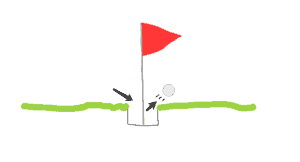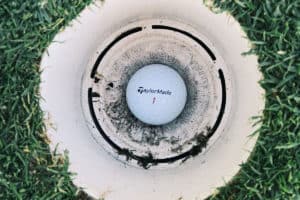Chances are, there has been a time where you were making a putt during a round of golf and your ball made its way to the hole…and then bounced out. This may have made you wonder, if a golf ball bounces out of the hole, is it in? So what do you do, does it count? It’s important to take the proper course of action in case this does happen to you, so I did a little bit of research to find exactly what happens when a ball bounces out of the cup.
What happens when a golf ball bounces out of the hole? According to the USGA Rules, when a golf ball bounces out of the hole, it is not considered a ‘holed ball’. The ball must be played from where it came to a full stop after bouncing out of the hole.
What Do You Do When Your Ball Bounces Out of the Cup?
Basically, in the instance where a ball bounces out of the cup, the player has to count the putt as a stroke and continue their turn until they completely sink their ball into the cup. Essentially, a golf ball that bounces out of the cup is still in play, and is not counted as a ‘holed ball’.

Why Is a Ball Not ‘Holed’ When It Bounces Out of the Cup?
So if you are wondering why your ball should not be counted as a ‘holed’ ball when it bounces out of the cup, it ultimately comes down to one thing, your ball must be at rest in the cup to be considered a holed putt. In other words, your golf ball has to hit the bottom of the cup, and stay there, for it to count as a ‘hole out’.
When Is a Ball Considered ‘Holed Out’?
the USGA says there are 2 factors in order for a golf ball to be ‘holed out’ or ‘holed’. The entire golf ball must be both below the surface at the cup and completely at rest.

So that means, if your ball pops out of the hole, then it was not at rest in the cup nor below the surface of the ground, and should not be considered a holed ball.
If you still have trouble understanding why a ball that pops out of the hole does not count, I thought of an example that may help explain this. Let’s say that you hit your ball a bit off the fairway and it lands in a bunker, but has enough speed and rolls out of the bunker. It wouldn’t make sense for the player to play their ball from the bunker because it is only important where the ball stops rolling. This is the same concept when talking about a ball on the putting green.
To show you a real life example of what happens when a ball bounces out of the hole, there is a video here where Tiger Woods’ fairway shot bounced onto the green, into the hole…and then out of the hole. While it’d be great for the ball to be counted as a ‘hole out’ (giving Tiger Eagle for that hole), the rules state that he must continue his turn until the ball is completely at rest in the hole.
When Is a Golf Ball Considered ‘At Rest’
What does it really mean for a ball to be at rest? A golf ball is considered ‘at rest’ when it has come to a complete halt. The ball must stop moving entirely for a player to take their next stroke.
So for the sake of sinking a putt, the ball is at rest when it is settled at the bottom of the cup.
How to Avoid Bouncing the Golf Ball Out of the Hole
Now that we know that having a golf ball bounce out of the cup adds a stroke to your score, it’s important to understand why this happens, so that it can be avoided in the future. There are two main reasons why a ball bounces out of the hole:
- The ball is going too fast to drop into the hole
- The cup is too shallow
While you may not have control over how shallow or deep the cup is, you do have control over the speed at which your golf ball travels on the green. To slow down your putt, you can do two things. The first thing to focus on is reducing your backswing. By reducing your backswing, you ultimately reduce the amount of force you are transferring to the golf ball, thus reducing ball speed.
The second way to reduce your ball speed, and avoid bouncing your golf ball out of the cup, is by using a heavier putter. By having a putter that has extra weight, it will be harder for you to swing your club fast, so it will ultimately slow down the speed of your putt.



